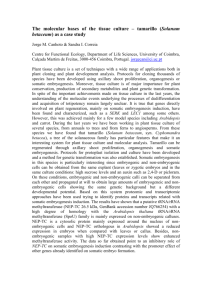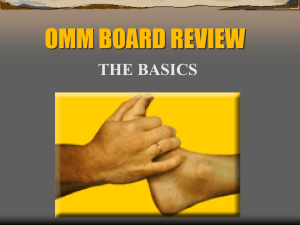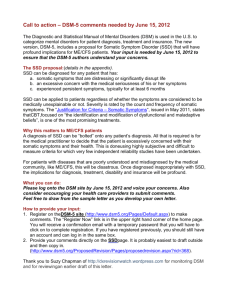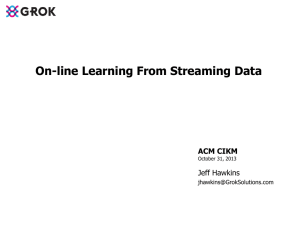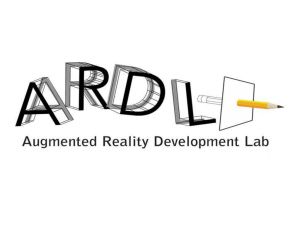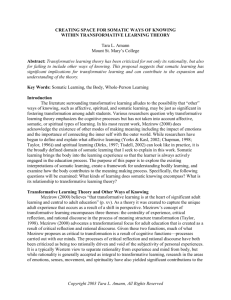somatic marker
advertisement
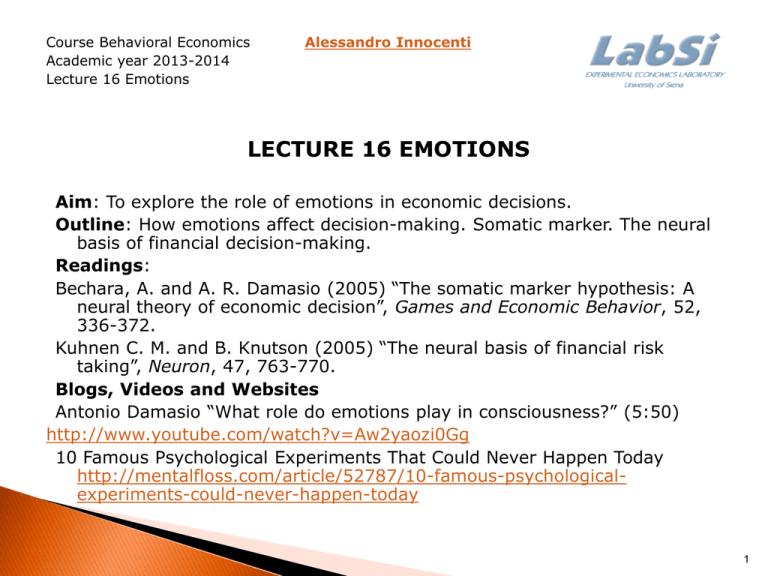
Course Behavioral Economics Academic year 2013-2014 Lecture 16 Emotions Alessandro Innocenti LECTURE 16 EMOTIONS Aim: To explore the role of emotions in economic decisions. Outline: How emotions affect decision-making. Somatic marker. The neural basis of financial decision-making. Readings: Bechara, A. and A. R. Damasio (2005) “The somatic marker hypothesis: A neural theory of economic decision”, Games and Economic Behavior, 52, 336-372. Kuhnen C. M. and B. Knutson (2005) “The neural basis of financial risk taking”, Neuron, 47, 763-770. Blogs, Videos and Websites Antonio Damasio “What role do emotions play in consciousness?” (5:50) http://www.youtube.com/watch?v=Aw2yaozi0Gg 10 Famous Psychological Experiments That Could Never Happen Today http://mentalfloss.com/article/52787/10-famous-psychologicalexperiments-could-never-happen-today 1 HOW EMOTIONS AFFECT DECISION-MAKING Spotlight of information processing - to focus attention on certain kinds of information (Boyer 1991) To encode and recall information – affect-as-information mechanism (Slovic et al. 2002) Motivator by influencing approach-avoidance tendencies and effort to process information (Zeelenberg-Pieters 2006) To provide a common currency for experiences in judgment and decisions, just as money for goods (Cabanac 1992) Driving decision-making in complex and conflicting choices markers can help decide - somatic marker (Damasio 1994) 2 SOMATIC MARKER Somatic markers are associations between reinforcing stimuli that induce an associated physiological affective state, that produce a net somatic state. Somatic states can be induced from (1) primary inducers (2) secondary inducers. Primary inducers are innate or learned stimuli that induce pleasurable or aversive states. Once present in the immediate environment, they automatically and obligatorily elicit a somatic response. Secondary inducers are entities generated by the recall of a personal or hypothetical emotional event, i.e., “thoughts” and “memories” of the primary inducer, which elicit a somatic response. This state biases our decision of how to act, or unconsciously, via the brainstem and ventral striatum, or consciously, engaging higher cortical cognitive processing. Damasio proposes that somatic markers direct attention towards more advantageous options, simplifying the decision process. 3 BRAIN PROCESSES According to Damasio, two distinct pathways reactivate somatic marker responses. In the first pathway, emotion can be evoked by the changes in the body that are projected to the brain—called the “body loop” (to see a snake) In the second pathway, cognitive representations of the emotions can be activated in the brain without being directly elicited by a physiological response—called the “as-if body loop”. (imagine and encounter with a snake The brain can anticipate expected bodily changes, which allows the individual to respond faster to external stimuli without waiting for an event to actually occur. 4 SOMATIC MARKER AND DECISION-MAKING Somatic marker hypothesis explains because a defect in emotion causes an impaired ability to make “good” decision making To assess the value of the available choices available in complex and conflicting tasks, cognitive processes may become overloaded and unable to help us decide. In dual system theory System 1’s impressions cannot be modified or confirmed by System 2 In terms of affect heuristic (Slovic et al. 1982) “the answer to an easy question (How do I feel about it?) serves as an answer to a much harder question (What do I think about it?)” (Kahneman, Thinking fast and slow p. 139) In this way, people’s emotional evaluation of outcome, and the bodily states and the approach and avoidance tendencies associated with them, play a central role in guiding decisionmaking 5 REINFORCEMENT MECHANISM When making decisions in the future, these physiological signals (or ‘somatic markers’) and its evoked emotion are consciously or unconsciously associated with their past outcomes and bias decision-making towards certain behaviors while avoiding others. For instance, when a somatic marker associated with a positive outcome is perceived, the person may feel happy and motivate the individual to pursue that behavior. When a somatic marker associated with the negative outcome is perceived, the person may feel sad and act as an internal alarm to warn the individual to avoid a course of action. These situation-specific somatic states based on, and reinforced by, past experiences help to guide behavior in favor of more advantageous choices and therefore are adaptive. 6 HOW EMOTIONS AFFECT DECISION-MAKING Somatic markers are probably stored in the ventromedial prefrontal cortex 7 TESTING SOMATIC MARKER IOWA GAMBLING TASK Bechara et al (1994) - Damasio (1994) http://www.millisecond.com/download/library/v3/IowaGamblingTask /IowaGamblingTask.web Experiment: Iowa Gambling task A B Disadvantageous decks Lead to overall loss C D x 100 Trials Advantageous decks Lead to overall gain Risky option (high variance) Safe option (low variance) 8 FINDINGS Patients with frontal lobe damage could generate a skin conductance response to “startle” as could “normal” patients. However, frontal damage patients did not generate any skin conductance response to “disturbing” pictures. In gambling experiments, the frontal lobe damaged patients continued to choose the high gain / high risk option and continued to loose as a result while normals tended towards the low risk / low gain option to receive a net gain. Both normal and frontal lobe damage patients generated a skin conductance response as each punishment and reward was issued. The normal subjects developed (acquired) an increasing skin conductance response immediately prior to selecting from the high risk option while frontal lobe damage patients showed no acquired anticipatory response whatsoever. This demonstrated that frontal lobe damage patients were not merely insensitive to punishment but had developed myopia for the future. 9 THE NEURAL BASIS OF FINANCIAL RISK-TAKING Kuhnen and Knutson (2005) Slides Kuhnen Is individual investor deviation from optimal behavior due to emotion? Brain imaging evidence that anticipation of gains vs. losses activate different regions Nucleus accumbens (NAcc) of ventral striatum =gains Anterior insula = loss Examined whether anticipatory neural activity could predict optimal and suboptimal choices in financial choices Event related fMRI with 1.5T scanner 19 subjects (experts and non-experts) Behavioral Investment Allocation Task (BIAS) ◦ 20 blocks 10 trials each ◦ Randomly assigned one stock to be bad and other good (subjects do not know which) Good stock (50% 10 dollari – 25% 0 dollari – 25% -10$ EV +2,5) Bad stock (25% 10 dollari – 25% 0 dollari – 50% -10$ EV -2,5) 10 The top panels depict the contrast of large gains versus large losses during the Outcome period following stock choice. The bottom panels depict the contrast of chosen versus unchosen outcomes during the Market period following stock choice. n = 19.12 FINDINGS Nucleus accumbens activation • before choosing a stock • after a choice in which the gain is relatively higher Anterior Insula activation • before choosing a bond • after a choice in which the gain is relatively lower Interpretation distinct neural circuits linked to anticipatory affect promote different types of financial choices excessive activation of these circuits may lead to investing mistakes activation in the NAcc and anterior insula, respectively, index positive and negative anticipatory affective states and this can lead to a shift in risk preferences. 13 APPLICATIONS Nucleus accumbens is activated two seconds before a person makes a risky and/or wrong choice (i.e one that results in an unprofitable outcome) People have neurobiological markers that indicate the rightness or anticipation of a risky decision. The brain knows before we become fully aware of it that we are on the verge of yielding to a misleading decisional impulse. This explain why casinos surround their guests with rewardcues (e.g., inexpensive food, free liquor, surprise gifts,potential jackpot prizes)—anticipation of rewards activates the NAcc, These offers may lead to an increase in thelikelihood of individuals switching from risk-averse to risk-seeking behavior. 14 NEURAL BASIS OF CONSUMPTION On the other hand, the insula responded significantly only at the moment preceding a suboptimal and riskless choice when people look at photographs of accidents, catastrophes and mutilated bodies this activates the insula whose activity is correlated with a diminished risk-taking behavior. This finding may apply to the marketing strategies employed by insurance company Kuhnen et al. 2007 extend this result to consumers behavior Product preference activated the nucleus accumbens (NAcc), while excessive prices activated the insula and deactivated the mesial prefrontal cortex (MPFC) prior to the purchase decision Activity from each of these regions independently predicted immediately subsequent purchases above and beyond self-report variables These findings suggest that activation of distinct neural circuits related to anticipatory affect precedes and supports consumers' decisions 15
